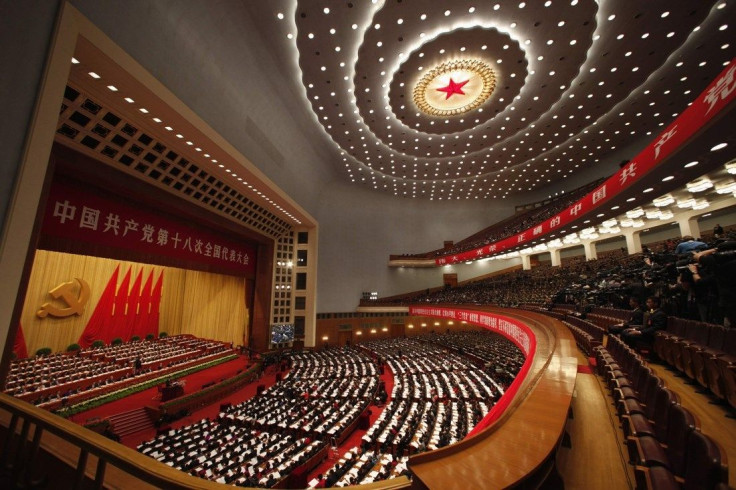Is China’s October Data (Posted Amid Leadership Change) Too Good To Be True?

Chinese October economic data, published amid the country’s once-a-decade leadership transition, offered the strongest sign so far of a recovery that’s gathering steam. However, given that the data was published while the Party Congress is in session, some skeptics have questioned whether the figures can be believed.
Growth of industrial production, fixed asset investment and retail sales all picked up more than expected in October, suggesting that the world’s second-largest economy has ended its nearly two-year slowdown.
Consumer price inflation cooled to a 33-month low, possibly opening the door to more policy easing, while factory-gate prices appear to have bottomed out. Economists expect the next export and import growth report, scheduled to be released over the weekend, to be largely stable.
“What a lovely data set to welcome in China’s new set of leaders. The stabilization looks to be on firmer ground,” wrote IHS Global Insights analysts Xianfang Ren and Alistair Thornton.
Despite the latest set of positive numbers, China is still on track to mark its most sluggish year in more than a decade. China's economy grew 7.4 percent in the third quarter, the slowest quarterly growth in more than three years.
“In our view, there is solid evidence of a turnaround but not of a strong rebound,” wrote Mark Williams and Qinwei Wang of Capital Economics in a note.
Hu Jintao, China’s soon-to-retire party secretary, has set a new growth target for China. “On the basis of making China’s development much more balanced, coordinated and sustainable, we should double its 2010 GDP and per capita income for both urban and rural residents [by 2020],” Hu said in a speech to the congress on Nov. 8.
Beijing has been fine-tuning economic policy for a year to support growth, and economists expect that program to broadly remain in place after the leadership changeover.
"The key question for investors is whether China's economic growth has truly bottomed out," Bank of America Merrill Lynch's China economist Ting Lu wrote in a note to clients.
"Based on October data … the answer is firmly 'yes'," said Lu, who expects China's GDP growth to run at an 8.3 percent pace in the first half of 2013, picking up from a 7.8 percent rate in the last three months of this year.
Stronger Data
Among the data highlights, industrial output growth rose to 9.6 percent last month, higher than the 9.4 percent rise forecast by analysts, and marking an improvement from September’s 9.2 percent gain. The pick-up was largely driven by heavy industry, with growth in light industry weaker and little changed.
“Anyone skeptical that the output data accurately reflect the strength of the economy should be reassured by a sizable acceleration in electricity production,” said Mark Williams and Qinwei Wang of Capital Economics.
Electricity production -- viewed by some as a more accurate measure of China’s economic growth -- has mounted a significant recovery, up 6.4 percent in October from a year earlier, its best performance since March.
The rebound in China’s power-output growth reflects recent strength in the nation's manufacturing sector and government policies implemented to boost infrastructure investment.
Retail sales were up 14.5 percent in October from a year earlier, underlining the continued resilience of consumer spending.
“Considering the lower inflation rate in October, retail sales volume actually improved more,” Societe Generale economist Wei Yao said in a note. “This is one more piece of evidence that rebalancing of the Chinese economy is making progress this year.”
Meanwhile, fixed-asset investment -- a measure of spending on construction, plant equipment and other projects — also picked up, growing 20.7 percent in the first 10 months of the year from a year ago.
There was another positive surprise in Friday’s inflation data. Consumer inflation eased to its slowest pace in nearly three years in October, with the 1.7 percent gain from a year ago slower than the 1.9 percent posted in September and well below the government’s overall inflation target of 4 percent for the year.
The producer price index in October fell 2.8 percent from the year-earlier period, a touch faster than the forecast fall of 2.7 percent but easing from September's 3.6 percent annual drop, which bodes well for a corporate sector struggling to cope with falling profits due to producer price deflation.
“With inflation still falling, policymakers have more room to stimulate the economy, but the activity data suggest there is no pressing need,” said Mark Williams and Qinwei Wang of Capital Economics. “But we don’t believe policy easing has ended. The recovery so far is modest.”
“Policy easing will likely continue in Q4 [the fourth quarter] to support a growth recovery,” Zhang Zhiwei, an analyst with Nomura, wrote in a note to clients.
© Copyright IBTimes 2025. All rights reserved.






















